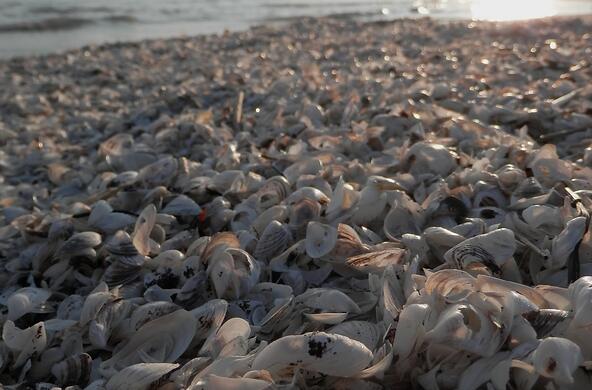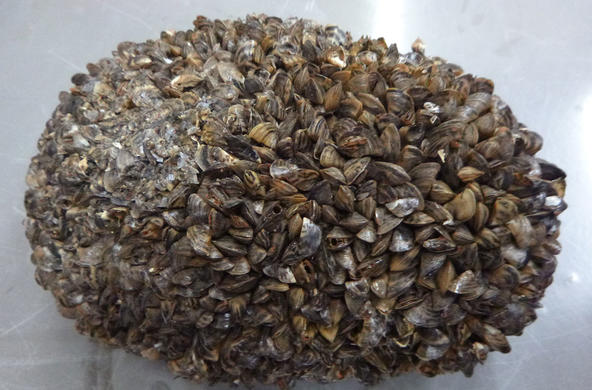The zebra mussel (Dreissena polymorpha) is a small bivalve originally native to the Caspian Sea region. Zebra mussels reached North America in the mid-1980s in the ballast water of a ship. They rapidly became established in the Great Lakes and the waters draining them.
Zebra mussels will eventually colonize most of the waters in North America except for places that are too saline or too warm for their survival. They are very efficient filter-feeders, which means that they filter small organisms and organic particles out of the water at very high rates.
The Invasion
Zebra mussels were first discovered in the Hudson at very low densities in 1991. By the end of 1992, they had spread throughout the river, and their biomass was greater than the combined biomass of all other consumers (fish, zooplankton, zoobenthos, bacteria) in the river.
Their densities can reach over 100,000 individuals per square meter. Since there are so many of them, they are able to filter all of the water in the freshwater portion of the Hudson River every 2-4 days! Before the invasion, the native mussels filtered the water only every 2-3 months. While some aspects of filtering the water are positive, the words “filter” and “clean” are not synonymous.
Zebra mussels are suspension feeders, eating phytoplankton, small zooplankton, large bacteria, and organic detritus by filtering the water and straining out the edible material. Phytoplankton and zooplankton form the base of the aquatic food web, so many animals depend on them for survival.
Effects on the Hudson Ecosystem
The zebra mussel invasion has had profound effects on the Hudson River ecosystem. The food web changes that the mussel has caused compare in magnitude to disturbances in other aquatic ecosystems caused by toxins, nutrient pollution, or acid rain.
Look at the map below to see where the zebra mussel (in red), and its similarly invasive relative, the quagga mussel (in green), have been found. Notice the stars in the middle of the country, indicating new invasion areas. These mussels were most likely brought to those areas by careless human activity.
As a result of the zebra mussels’ huge appetite, populations of plankton in the Hudson River have fallen sharply. Microzooplankton, like the rotifer pictured below, have declined by 70%, while phytoplankton have decreased by 80%. This means there is a lot less food available for fish, native mussels, and other river animals.
Water intake pipes provide an ideal habitat for the zebra mussel because they provide both protection and a constant flow of water, and, hence a constant food supply. Once zebra mussels are attached to a surface in an ideal environment, they multiply rapidly and form densely-packed colonies. Companies that use Hudson River water spend a lot of money to ensure that their pipes remain clear of zebra mussels.
Many native mussel populations have decreased to the point of being threatened or endangered, because they are out-competed by the zebra mussels.
Other animals, including fish like shad and herring that live in the open water, have also suffered. Dissolved oxygen levels have decreased, which can have different effects on different species.
In addition to indirect effects from ecological changes, zebra mussels have caused direct economic damage by attaching to hard substrates like drinking water intake pipes and power plant equipment. However, some organisms have benefited from the arrival of zebra mussels, such as the fish that live in the vegetated shallows of the river, like the redbreasted sunfish. Scientists believe the improved water clarity from the excess filtration allows more sunlight to reach rooted plants. More light allows for more plant growth, which provides more shelter for the organisms that the fish like to eat.
Zebra Mussel Life Cycle
On average, zebra mussels live 2-5 years and can reproduce by their second year. Each year, a mature female zebra mussel may release up to one million eggs, while the male may release more than two hundred million sperm into the water where fertilization takes place. In approximately two days, the fertilized eggs develop into free-swimming larvae called veligers, which can be transported over long distances by water currents. Within 2-3 weeks, the veligers begin to ‘settle-out’ in the water under the weight of their forming shells and attach to firm, underwater surfaces.
Zebra mussels cling to surfaces by using thread-like strands called byssal fibers tipped with a strong, sticky substance. As many as seven hundred thousand mussels can occupy a square meter. Once attached, they generally stay in one place, but can detach and crawl to a new location if environmental conditions change.
In addition to water currents, zebra mussels can be transported by hitch-hiking on boats, boat trailers, sea planes, and other aquatic equipment. Adult zebra mussels feed by filtering large amounts of plankton and detritus from the water. Each mussel can filter one liter of water per day!
Zebra mussels cling to any hard surface— including native mussels and other shelled animals. These animals die because they can’t feed.
Zebra mussels can upset food webs in other ways, too. These filter feeders pump water through their gills and strain out microscopic animals and plants called plankton. Zebra mussels can quickly clear out huge bodies of water, removing food for the native invertebrates and small fish.
Zebra mussels can also affect humans — and cause million of dollars in damage. The mussels clog water pipes to businesses and power plants. They damage boats, docks, buoys, and other structures. And their shells wash up in huge numbers on beaches.
Zebra mussels thrive in nutrient-rich water which supports healthy populations of plankton. Substantial levels of calcium are required for shell production as are firm surfaces to which the mussels can attach. They like slightly alkaline water with temperatures between 68-77˚ F, but can survive more extreme ranges.
Recent research has shown that zebra mussels may be susceptible to predation from fish and crabs in the Hudson River. Scientists are trying to figure out which types of animals eat the zebra mussels, and how this affects their population in the river.
Glossary
Alien species: a species that was moved outside of its native range by human activities (also called exotic, non-native, non-indigenous, introduced). This does not apply to domesticated species.
Byssal fibers: thread-like strands adult zebra mussels produce to attach to firm objects
Detritus: bits of vegetation, animal remains or waste, and other organic material that form the base of food chains in many ecosystems
Drainage basin: a region including land and water which drains to a particular point; also called a watershed
Ecosystem: a system of interrelated organisms together with their physical and chemical environment
Food chain: the sequential transfer of food energy from one species to another. Higher species in the chain consume lower species in the chain.
Invasive species: a non-native, or alien species, that is aggressive and displaces native species
Mollusk: a soft-bodied aquatic animal, typically protected by a hard shell, such as a snail, clam, or mussel.
Plankton: small, usually microscopic, plants and animals that float in the water
Predator: an animal species that captures other animals, its prey
Veliger: microscopic juvenile stage of the zebra mussel



